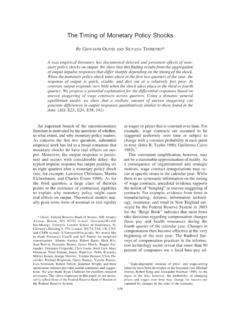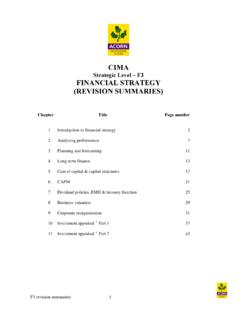Transcription of BANKING & FINANCIAL SERVICES - Genpact
1 BANKING & FINANCIAL SERVICESR emediation as a Service: A cost-effective response to regulatory and strategic changeExecutive summary: In recent years, the annual cost of client data remediations to the FINANCIAL SERVICES industry has soared to hundreds of millions of dollars. This development is driven by a variety of factors, including regulatory and enforcement actions, internal policy changes, mergers and acquisitions, and technology upgrades. The tougher regulations enacted since the 2007 FINANCIAL crisis have greatly increased the need for accuracy in client data. This has driven up demand for the specialists who can perform data remediation, while forcing managers to divert resources from their other compliance efforts at a time when margins are already under pressure.
2 However, some organizations are finding that the combination of shared SERVICES with an industrialized approach enables them to perform data remediation at a lower cost and in a more scalable, consistent, and transparent with intense political pressure following the FINANCIAL crisis, regulators around the world have come down hard on FINANCIAL institutions hitting firms that fall out of compliance in their client record-keeping with fines that run into the tens of millions of dollars. This crackdown comes as FINANCIAL institutions already are grappling with margin pressures following the crisis, and hence, are trying to stretch the dollars they allocate on traditional cost centers such as compliance, operations, IT, and risk management.
3 As a result, many FINANCIAL institutions are searching for solutions that will enable them to fulfill these new regulatory obligations and at a lower cost than before. For FINANCIAL institutions, this combination of regulatory and business pressures is creating pain points throughout their organization. In the case of client account remediation, compliance staff may struggle to implement the appropriate policy changes, while operations faces a lumpy flow of work from forces that are difficult to anticipate. Given that institutions cannot scale these processes for a short-term remediation project, backlogs can occur creating additional and unnecessary risks.
4 Such backlogs can be exacerbated by internal decisions as well. This forces firms to weigh the effects of other strategic initiatives such as the ability to create a consolidated view of each customer s account against the effects of potential remediation is important that all stakeholders in the regulatory value chain recognize their core strengths and responsibilities and refocus their efforts to maximize the return on allocated BodiesCEO/Board, CFOC omplianceOperationsRiskIT & Procurement Reporting and Audit ComplianceReport and Audit (Internal and External)Clear customer data and risk categoryReduce backlogs of unremediated filesNew compliance standards to be met seamlesslyCost efficient, consistent, and auditable executionReduce manual and fragmented systems and processesSingle customer viewShort- and long-term expectations to meet expanded regulatory requirements within budgetDynamic compliance expectations, increased fines/sanctionsRegulatory Compliance Value ChainComplicating matters is that each of the internal stakeholders within an organization may have different needs and goals during this time.
5 Chief Executive Officers seek full regulatory compliance with as little effect on business operations as possible Chief FINANCIAL Officers are looking to generate maximum returns from each of the allocated budgets Compliance Officers want uninterrupted compliance with rules that reflect industry best-practices and leave an easy audit trail Operations Managers put a premium on scalable and cost-efficient resources that deliver consistent results Risk Managers want transparent processes with no backlogs, continuous monitoring capabilities, and a complete audit trail IT Executives need a non-invasive solution that spans the enterprise with little or no upfront investmentTo deliver the maximum value for each dollar allocated, the solution also must be scalable and make the best use of both processes and technology.
6 For FINANCIAL institutions, developing the people and technology to be able to meet these requirements while generating maximum ROI (Return on Investment) is no small task. However, when the solution is redrawn as part of an as a service model, there is a greater ability to satisfy the needs of each internal arrive at the right solution, it is important to understand what is causing the recurring spikes in remediation and renewal efforts seen across the industry. These challenges relate to two broad forces: increased regulation and the strategic changes within course, satisfying internal stakeholders is only half of the equation.
7 The punitive sanctions and monetary fines issued by regulators shows that FINANCIAL institutions must get serious about complying with the tighter customer-data requirements. As a result, FINANCIAL institutions face the daunting challenge of complying with the new regulations while also carefully measuring their policy response and FINANCIAL investment in compliance formulating a response to the changing regulations, executives and managers particularly those in operations must consider the following challenges: Risk management. Managers must maintain a strong, but flexible, risk mitigation effort even as the regulatory environment changes Audit trail.
8 Managers must keep a clear view of all remediation activity and make it available to auditors Working with multiple regulators. This includes designing large-scale remediation efforts to remain compliant with the regulatory standards set by different regulators across all jurisdictions Customer data. Ensuring customer-data security throughout all stages of remediation efforts Internal policy. Ensuring total compliance with minimal effects on normal business activitiesExamining the needs of each of the major stakeholders in the regulatory compliance value chain can help set the boundary conditions for a remediation work solution.
9 Technology. Integrating remediation processes with other company platforms and data vendors as part of a strategic solutionOf all these challenges, the demand by regulators for a more robust audit trail for both internal and external stakeholders can present a particular challenge for managers leading remediation projects particularly those that are large and complex. That said, maintaining a clear, transparent, and easily auditable remediation process is an important pillar of any remediation solution that is designed to be strategic, cost-effective and addition to the costs of complying with the regulatory changes, FINANCIAL institutions also are struggling with tighter margins.
10 While some of this margin pressure is due to the restrictions regulators have placed on riskier activities like proprietary trading, there are other forces at work. Increased competition, changing customer requirements, and advances in technology are also putting pressure on the operating models of many institutions. As a result, institutions have few opportunities to reduce costs without affecting their ability to comply with the new regulatory regime. Cleaning, reviewing and remediating entity data requires a staff of specialists a solution that is not always easy to scale. However, scalability can be important given the uneven and unpredictable nature of remediation workflows Maintaining a work flow that s free of backlogs can be costly, since the only alternatives are increasing permanent staff or entering into large-scale consulting engagementsProcess and technology challenges: Many institutions that recorded rapid growth over the past decade failed to implement standardized remediation processes across business lines and geographies.


















